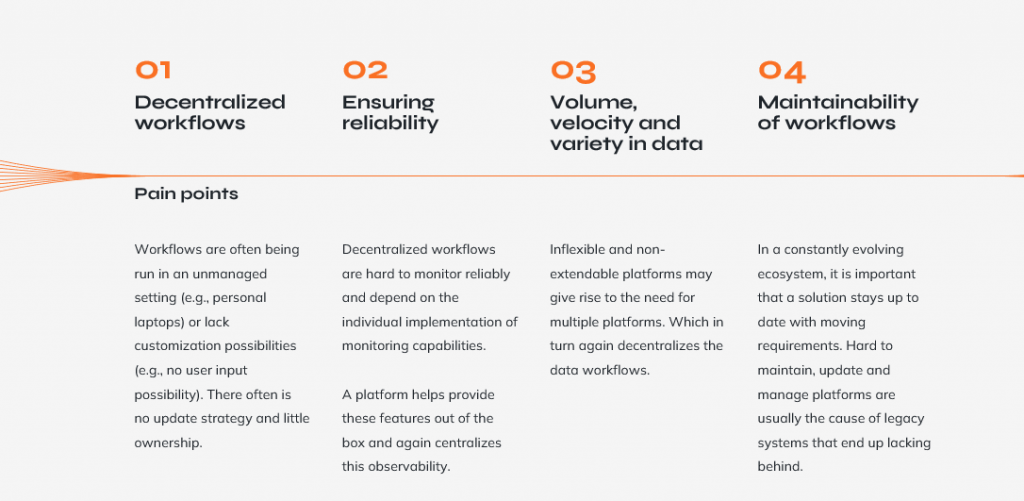Pharmaceutical company improves OEE by 10% in 6 months by achieving maintenance excellence





In the fast-paced world of data science and engineering, efficient workflow management is key. Pfizer, a top pharmaceutical company, excels in this area. They use Apache Airflow, a workflow orchestration tool, to streamline operations. This open-source platform is designed to author, schedule, and monitor workflows programmatically.

Our comprehensive webinar featured Pfizer’s data science and engineering team. They shared insights on implementing Apache Airflow and its benefits. Otofacto has been part of this journey from day one and participated in the decision made to build a tech stack. We accompanied Pfizer in their journey to choose Apache Airflow.
The team stressed the need for a robust, flexible workflow management system. It should handle complex tasks, provide centralized logging, and support automated alerting. They also discussed the importance of standardization. This promotes development tasks to production and includes code reviews and tagging for maintainability.
The webinar explored Apache Airflow’s practical application in Pfizer’s operations. The team shared use cases, such as maintaining databases, orchestrating microservices, and automating manual labor. They highlighted their efforts to promote a data-oriented culture. They provide data snapshots for different departments to explore and learn from.
Towards the end, the team discussed future plans. They plan to incorporate S3 compatible storage and rework Airflow’s backend. This makes it more accessible for non-Python developers. They also plan to leverage more event-driven logic in workflows, a feature recently introduced in Apache Airflow version 2.4.
This article aims to provide a comprehensive overview of Pfizer’s journey with Apache Airflow, offering valuable insights for organizations looking to optimize their workflow management systems.
➡️ Immediately receive the replay of the webinar

In today’s data-driven world, the ability to manage and orchestrate workflows effectively is a critical success factor for any organization. As businesses increasingly rely on data to drive decision-making, the need for efficient data management systems has never been greater. This is where workflow orchestration comes into play.
Workflow orchestration involves the automated arrangement, coordination, and management of complex computer systems, services, and middleware. It’s about creating systems that can understand, learn, predict, adapt, and potentially even function autonomously. These systems learn and adapt as they gather more data, making them increasingly efficient and effective.
One of the key components of workflow orchestration is the Extract, Transform, Load (ETL) process. ETL processes and data pipelines are the backbone of any data-driven business. They allow businesses to extract data from various sources, transform it into a usable format, and load it into a data warehouse for analysis and decision-making.
However, managing ETL processes and data pipelines can be a complex and time-consuming task. This is where an orchestrator like Apache Airflow comes into play. Apache Airflow is an open-source platform that allows businesses to programmatically author, schedule, and monitor workflows. It provides a robust and flexible solution for managing complex ETL processes and data pipelines.
By leveraging Apache Airflow, businesses can automate the orchestration of their workflows, reducing the need for manual intervention and increasing efficiency. This not only saves time and resources but also reduces the risk of errors, ensuring that the workflows are carried out accurately and reliably.
In the context of workflow management, the use of an orchestrator like Apache Airflow can provide significant benefits. It can help businesses streamline their operations, improve efficiency, and ultimately drive better decision-making through the effective use of data.
In the complex ecosystem of a global pharmaceutical company like Pfizer, the ability to manage and orchestrate workflows effectively is paramount. Pfizer, known for its innovative approach to data management, recognized the need for a robust and flexible workflow management system. Their choice? Apache Airflow.
Apache Airflow’s ability to handle complex tasks, provide centralized logging, and support automated alerting made it an ideal choice for Pfizer. It offered a standardized way of working to promote development tasks to production, which includes code reviews and tagging to ensure maintainability.
The implementation of Apache Airflow within Pfizer’s ecosystem has been transformative. It has allowed Pfizer to automate and optimize their workflows, leading to improved efficiency and productivity. Furthermore, the team at Pfizer has been able to significantly reduce the time their data scientists spend on collecting and preparing data, allowing them to focus more on modeling, deployment, and analysis.
Several use cases within Pfizer highlight the effectiveness of Apache Airflow. These include ensuring the maintainability of databases, orchestrating microservices, and automating manual labor within their department. By providing snapshots of data for different departments to explore and learn from, Pfizer has also been successful in promoting a data-oriented culture within the company.
Looking ahead, Pfizer plans to further leverage Apache Airflow in their operations. They are interested in incorporating S3 compatible storage and reworking the backend of Airflow to make it more accessible for non-Python developers. They also plan to leverage more event-driven logic in their workflows, a feature recently introduced in Apache Airflow version 2.4.
The integration of Apache Airflow into Pfizer’s ecosystem serves as a powerful testament to the benefits of effective workflow management. It demonstrates how businesses can leverage technology to streamline their operations, improve efficiency, and drive better decision-making.
As we delve deeper into the era of digital transformation, the future of workflow management holds many possibilities. Pfizer, a global leader in the pharmaceutical industry, is at the forefront of this transformation, leveraging advanced technologies to streamline operations and drive innovation.
Pfizer’s primary objective is to ensure the efficient and effective management of their workflows, particularly in the context of data management. The company recognizes the critical role that data plays in their operations, from drug discovery and development to market analysis and decision-making.
To achieve this objective, Pfizer has implemented Apache Airflow, a powerful tool that allows them to automate and optimize their workflows. Nevertheless, Pfizer’s vision extends beyond the current capabilities of Apache Airflow. The team is already looking ahead, planning to incorporate S3 compatible storage and rework the backend of Airflow to make it more accessible for non-Python developers. They also plan to leverage more event-driven logic in their workflows, a feature recently introduced in Apache Airflow version 2.4.
These future plans reflect Pfizer’s commitment to continuous improvement and innovation in their workflow management. By staying ahead of the curve, Pfizer is positioning itself to further optimize its operations, improve efficiency, and drive better decision-making.
But Pfizer’s objectives are not just about improving efficiency. They are also focused on promoting a data-oriented culture within the company. By providing snapshots of data for different departments to explore and learn from, Pfizer is encouraging its employees to make more data-driven decisions, fostering a culture of innovation and continuous learning.
In conclusion, Pfizer’s vision for the future of workflow management is both ambitious and inspiring. It demonstrates how businesses can leverage technology to not only improve their operations but also drive a culture of innovation and continuous learning.
The deployment strategy forms a critical cornerstone of any successful project. It’s not merely about crafting the AI model; it’s about effectively integrating it into the real world. Planning the deployment strategy from the project’s inception is vital. It’s not an afterthought that comes into play once the model is developed.
The implementation of Apache Airflow at Pfizer stands as a testament to the power of effective workflow management, particularly when equipped with a robust workflow orchestration tool.
Central to Pfizer’s implementation is Apache Airflow’s Directed Acyclic Graph (DAG) model. This model empowers Pfizer to define complex workflows by specifying the sequence of tasks and their dependencies. In this model, each task in the workflow is represented as a node in the graph, while the dependencies between tasks are represented as edges.
To cater to their specific needs, Pfizer’s team has developed a range of custom operators for their Airflow workflows. These operators manage tasks ranging from data extraction, transformation, and loading to more complex tasks such as orchestrating microservices and automating manual labor within their department.
In order to ensure the maintainability of their workflows, Pfizer has implemented a standardized way of working. This includes practices such as code reviews and tagging, which ensure that their workflows are not only efficient but also maintainable over time. Importantly, this approach has been instrumental in promoting a data-oriented culture within the company, as it provides snapshots of data for different departments to explore and learn from.
Looking ahead, Pfizer has plans to further enhance their implementation of Apache Airflow. They are interested in incorporating S3 compatible storage to facilitate the storage and retrieval of data. Additionally, they plan to rework the backend of Airflow to make it more accessible for non-Python developers, thereby broadening the range of people who can contribute to their workflows.
In conclusion, the technical implementation of Apache Airflow at Pfizer serves as a powerful example of how businesses can leverage technology to streamline their operations and drive innovation. It clearly demonstrates that with the right tools and approach, businesses can effectively manage their workflows, improve efficiency, and foster a culture of continuous learning and innovation.
The implementation of Apache Airflow at Pfizer has led to significant improvements in various aspects of their operations. Here are some specific use cases where Apache Airflow has been instrumental in streamlining Pfizer’s workflows and improving efficiency.
One of the key use cases of Apache Airflow at Pfizer is in ensuring the maintainability of databases. Pfizer’s databases are critical to their operations, storing vast amounts of data that drive decision-making across the company. Apache Airflow allows Pfizer to automate the process of updating and maintaining these databases, ensuring that they are always up-to-date and reliable.
Pfizer also uses Apache Airflow to orchestrate microservices. Microservices are small, independent services that work together to form a larger application. By using Apache Airflow, Pfizer can effectively manage the interactions between these microservices, ensuring that they work together seamlessly.
Another significant use case of Apache Airflow at Pfizer is in automating manual labor within their QA department. By automating repetitive tasks, Pfizer has been able to free up their team to focus on more strategic, high-value tasks. This has not only improved efficiency but also increased job satisfaction among their team members.
Finally, Pfizer has used Apache Airflow to promote a data-oriented culture within the company. By providing snapshots of data for different departments to explore and learn from, Pfizer is encouraging its employees to make more data-driven decisions. This has fostered a culture of innovation and continuous learning within the company.
In conclusion, these use cases highlight the versatility and power of Apache Airflow. Whether it’s maintaining databases, orchestrating microservices, automating manual labor, or promoting a data-oriented culture, Apache Airflow provides a robust and flexible solution for managing workflows.
➡️ Curious to learn more about this Success story? Download the replay here!
Let’s talk about
– The key features and capabilities that make these orchestrators an indispensable tool for you
– How you can implement it into your workflow practices